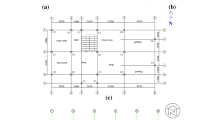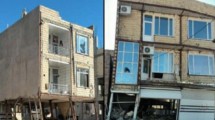Abstract
The Los Angeles Soft-Story Ordinance was enacted with the goal of reducing the collapse risk of woodframe buildings with soft, weak and open-front (SWOF) wall lines. Four alternative retrofit methods are permitted under the Ordinance including a “SWOF-wall-line-only” retrofit in accordance with the Department of Building and Safety requirements or a “full-story” retrofit based on Appendix A4 of the 2012 IEBC, ASCE 41-13 or FEMA P807. A comparative assessment of the increase in collapse safety provided by the four alternative retrofit methods is presented. Nonlinear static and dynamic collapse analyses are conducted on a set of archetypical structural models, which have been developed based on an extensive survey of Los Angeles SWOF buildings. The effect of several building characteristics (e.g. number of stories, wall layout in 1st story) on the relative enhancement in collapse safety of the retrofitted buildings is also investigated. The number of stories is shown to have the greatest effect on the relative collapse safety benefits derived from the alternative methods. The number of SWOF wall lines and the ductility of the upper stories also impacted the extent to which the retrofits enhanced collapse safety.














Similar content being viewed by others
References
ASCE (2010) ASCE/SEI 7-10 minimum design loads for buildings and other structures. Reston, Virginia
ASCE (2013) ASCE/SEI 41-13 seismic evaluation and retrofit of existing buildings. Reston, Virginia
Bahmani P, Van De Lindt JW (2012) Numerical modeling of soft-story woodframe retrofit techniques for design. In: Structures congress 2012—Proceedings of the 2012 Structures Congress, pp 1755–1766
Bahmani P, van de Lindt JW, Gershfeld M et al (2016) Experimental seismic behavior of a full-scale four-story soft-story wood-frame building with retrofits. I: building design, retrofit methodology, and numerical validation. J Struct Eng 142:E4014003. https://doi.org/10.1061/(ASCE)ST.1943-541X.0001207
Christovasilis IP, Filiatrault A, Constantinou MC, Wanitkorkul A (2009) Incremental dynamic analysis of woodframe buildings. Earthq Eng Struct Dyn 38(4):477–496
Comerio M (2006) Estimating downtime in loss modeling. Earthq Spectra 22:349–365
FEMA (2012) Seismic evaluation and retrofit of multi-unit wood-frame buildings with weak first stories. FEMA P807, Washington
Folz B, Filiatrault A (2001) Cyclic analysis of wood shear walls. J Struct Eng. https://doi.org/10.1061/(asce)0733-9445(2001)127:4(433)
Harris SK, Egan JA (1992) Effects of ground conditions on the damage to four-story corner apartment buildings, The Loma Prieta, California, Earthquake of October 17, 1989—Marina District. In: O’Rourke TD (ed) United States Government Printing Office, Washington, DC, pp F181–F194
Holmes W, Somers P (1996) Northridge earthquake of January 17, 1994 Reconnaissance Report, Oakland, CA
Ibarra LF, Medina RA, Krawinkler H (2005) Hysteretic models that incorporate strength and stiffness deterioration. Earthq Eng Struct Dyn 34(1):1489–1511
IEBC (2012) 2012 International Existing Building Code. International Code Council, Country Club Hills
Jennings E, van de Lindt JW, Ziaei E et al (2015) Full-scale experimental verification of soft-story-only retrofits of wood-frame buildings using hybrid testing. J Earthq Eng 19:410–430. https://doi.org/10.1080/13632469.2014.975896
Krawinkler H, Parisi F, Ibarra L, Ayoub A. and Medina R (2001) Development of a testing protocol for wood frame structures, Technical Report, Stanford University, Stanford, Calif, CA, CUREE-Caltech Woodframe Project Report No. W-02
LADBS (2015) Mandatory wood frame soft-story retrofit program: structural design guidelines. Los Angeles Department of Building and Safety, Los Angeles
Li Y, Yin Y, Ellingwood BR, Bulleit WM (2010) Uniform hazard versus uniform risk bases for performance-based earthquake engineering of light-frame wood construction. Earthq Eng Struct Dyn 39(11):1199–1217
Lignos DG, Krawinkler H (2013) Development and utilization of structural component databases for performance-based earthquake engineering. J Struct Eng 139:1382–1394. https://doi.org/10.1061/(ASCE)ST.1943-541X.0000646
Lowes LN, Mitra N, Altoontash A (2004) A beam-column joint model for simulating the earthquake response of reinforced concrete frames. Pacific Earthquake Engineering Research Center, PEER Report 2003/10
Maison B, McDonald B, McCormick D, Schotanus M, Buckalew J (2014) Commentary on FEMA P807 for retrofit of wood-frame soft-story buildings. Earthq Spectra 30(4):1359–1380
Mazzoni S, McKenna F, Scott MH, Fenves Gregory L et al (2013) OpenSees [Computer Software]: the open system for earthquake engineering simulation. Regents of the University of California, Berkeley
Park S, van de Lindt JW (2015) Genetic optimization for seismic retrofit of soft-story woodframe buildings using FEMA P807 methodology. J Perform Constr Facil 29:04014153. https://doi.org/10.1061/(ASCE)CF.1943-5509.0000637
Schleuss J, Xia R (2016) Do you know if your L.A. home is at risk in an earthquake? Los Angeles Times. http://graphics.latimes.com/soft-story-apartments-needing-retrofit/
SEAOSC (2017) SEAOSC design guide: City of Los Angeles soft, weak and open-front wall line building ordiance. Structural Engineers Association of Southern California, Los Angeles
Sutley EJ, Van De Lindt JW (2016) Evolution of predicted seismic performance for wood-frame buildings. J Archit Eng. https://doi.org/10.1061/(asce)ae.1943-5568.0000212
Van De Lindt JW, Symans MD, Pang W et al (2012) Seismic risk reduction for soft-story woodframe buildings: the nees-soft project. In: World conference on timber engineering 2012, WCTE 2012, pp 237–243
Yin Y-J, Li Y (2010) Seismic collapse risk of light-frame wood construction considering aleatoric and epistemic uncertainties. Struct Saf 32:250–261. https://doi.org/10.1016/j.strusafe.2010.03.012
Acknowledgements
The research presented in this paper is supported by the National Science Foundation CMMI Research Grant No. 1538747.
Author information
Authors and Affiliations
Corresponding author
Additional information
Publisher's Note
Springer Nature remains neutral with regard to jurisdictional claims in published maps and institutional affiliations.
Appendices
Appendix 1: Floor plan dimensions of archetype buildings



Appendix 2: Details of retrofit elements
2.1 Retrofit frame sizes
2.2 FEMA P807 retrofit panel identification, lengths and nailing
For the FEMA P807 retrofits, the only WSPs are 5′-0″ long with 8d @ 4″ O.C. nailing located at P1 and P7 (see Fig. 4c) in the L3 archetypes, with the exception of L3-2S-50X30-HWS (no panels are included in the FEMA P807 retrofit of this archetype).
2.3 IEBC A4 retrofit panel identification, lengths and nailing
The IEBC retrofit panels are summarized in Table 6 where the panels are labelled X′-X″; NX. X′-X″ is the length of the panel and NX is the nailing. The 10d @ 2″ O.C. nailing pattern is denoted as “N1” and the 10d @ 4″ O.C. nailing pattern is denoted as “N2”.
See Table 6.
2.4 ASCE 41-13 retrofit panel identification, lengths and nailing
The ASCE 41-13 retrofit panel lengths are summarized in Table 7. Only the L3 archetypes have panels and the nailing pattern is always 10d @ 2″ O.C.
See Table 7.
Rights and permissions
About this article
Cite this article
Burton, H., Rad, A.R., Yi, Z. et al. Seismic collapse performance of Los Angeles soft, weak, and open-front wall line woodframe structures retrofitted using different procedures. Bull Earthquake Eng 17, 2059–2091 (2019). https://doi.org/10.1007/s10518-018-00524-w
Received:
Accepted:
Published:
Issue Date:
DOI: https://doi.org/10.1007/s10518-018-00524-w




